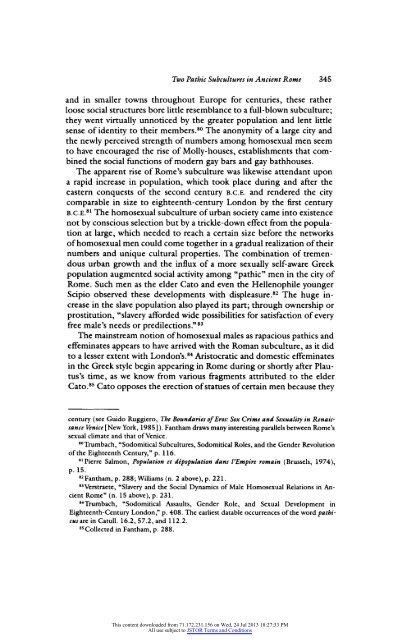Two Pathic Subcultures in Ancient Rome
Two Pathic Subcultures in Ancient Rome
Two Pathic Subcultures in Ancient Rome
You also want an ePaper? Increase the reach of your titles
YUMPU automatically turns print PDFs into web optimized ePapers that Google loves.
<strong>Two</strong> <strong>Pathic</strong> <strong>Subcultures</strong> <strong>in</strong> <strong>Ancient</strong> <strong>Rome</strong> 345<br />
and <strong>in</strong> smaller towns throughout Europe for centuries, these rather<br />
loose social structures bore little resemblance to a full-blown subculture;<br />
they went virtually unnoticed by the greater population and lent little<br />
sense of identity to their members.80 The anonymity of a large city and<br />
the newly perceived strength of numbers among homosexual men seem<br />
to have encouraged the rise of Molly-houses, establishments that comb<strong>in</strong>ed<br />
the social functions of modern gay bars and gay bathhouses.<br />
The apparent rise of <strong>Rome</strong>'s subculture was likewise attendant upon<br />
a rapid <strong>in</strong>crease <strong>in</strong> population, which took place dur<strong>in</strong>g and after the<br />
eastern conquests of the second century B.C.E. and rendered the city<br />
comparable <strong>in</strong> size to eighteenth-century London by the first century<br />
B.C.E.8' The homosexual subculture of urban society came <strong>in</strong>to existence<br />
not by conscious selection but by a trickle-down effect from the population<br />
at large, which needed to reach a certa<strong>in</strong> size before the networks<br />
of homosexual men could come together <strong>in</strong> a gradual realization of their<br />
numbers and unique cultural properties. The comb<strong>in</strong>ation of tremendous<br />
urban growth and the <strong>in</strong>flux of a more sexually self-aware Greek<br />
population augmented social activity among "pathic" men <strong>in</strong> the city of<br />
<strong>Rome</strong>. Such men as the elder Cato and even the Hellenophile younger<br />
Scipio observed these developments with displeasure.82 The huge <strong>in</strong>crease<br />
<strong>in</strong> the slave population also played its part; through ownership or<br />
prostitution, "slavery afforded wide possibilities for satisfaction of every<br />
free male's needs or predilections."83<br />
The ma<strong>in</strong>stream notion of homosexual males as rapacious pathics and<br />
effem<strong>in</strong>ates appears to have arrived with the Roman subculture, as it did<br />
to a lesser extent with London's.84 Aristocratic and domestic effem<strong>in</strong>ates<br />
<strong>in</strong> the Greek style beg<strong>in</strong> appear<strong>in</strong>g <strong>in</strong> <strong>Rome</strong> dur<strong>in</strong>g or shortly after Plautus's<br />
time, as we know from various fragments attributed to the elder<br />
Cato.85 Cato opposes the erection of statues of certa<strong>in</strong> men because they<br />
century (see Guido Ruggiero, The Boundaries of Eros: Sex Crime and Sexuality <strong>in</strong> Renaissance<br />
Venice [New York, 1985]). Fantham draws many <strong>in</strong>terest<strong>in</strong>g parallels between <strong>Rome</strong>'s<br />
sexual climate and that of Venice.<br />
80Trumbach, 'Sodomitical <strong>Subcultures</strong>, Sodomitical Roles, and the Gender Revolution<br />
of the Eighteenth Century," p. 116.<br />
8"Picrrc Salmon, Population et depopulation dans l'Empire roma<strong>in</strong> (Brussels, 1974),<br />
p. 15.<br />
82Fantham, p. 288; Williams (n. 2 above), p. 221.<br />
83Verstraete, "Slavery and the Social Dynamics of Male Homosexual Relations <strong>in</strong> <strong>Ancient</strong><br />
<strong>Rome</strong>" (n. 15 above), p. 231.<br />
"4Trumbach, "Sodomitical Assaults, Gender Role, and Sexual Development <strong>in</strong><br />
Eighteenth-Century London," p. 408. The earliest datable occurrences of the word pathicus<br />
are <strong>in</strong> Catull. 16.2, 57.2, and 112.2.<br />
"5Collected <strong>in</strong> Fantham, p. 288.<br />
This content downloaded from 71.172.231.156 on Wed, 24 Jul 2013 18:27:33 PM<br />
All use subject to JSTOR Terms and Conditions
















